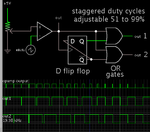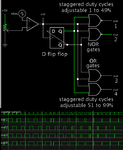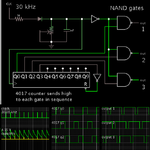David_
Advanced Member level 2
Hello.
I have been reading about multi-phase synchronous buck-converters and there benefits compared to a ordinary buck-converter, and I have seen but not really read about multi-phase boost converters.
Multi-phase converter means that instead of having a synchronous buck-converter built with one power stage(high-side & low-side MOSFET switches, inductor and possibly capacitors) you make several individual buck-converters that are connected parallel and by some means share the current load, which is a scheme that offers a hole load of useful results.
Anyway what I wonder is this, what about a multi-phase buck-boost converter?
What is the reason for why I can't find a single reference to such a circuit online?
I am trying to design a high-current 4-switch non-inverting buck-boost converter, high current being 45A while low voltages below 8,4V, and I was simply entertaining the idea of a dual-phase buck-boost converter which I admit sounds sort of strange and maybe even impractical given the amount of MOSFET's and MOSFET drivers that would entail, if I imagine such a converter with 3 phases then it starts to get out of hand. Could that be the answer, that a multi-phase buck-boost converter simply isn't practical due to the benefits of multiple phases not justifying the increase in the physical circuit and number of components?
Regards
I have been reading about multi-phase synchronous buck-converters and there benefits compared to a ordinary buck-converter, and I have seen but not really read about multi-phase boost converters.
Multi-phase converter means that instead of having a synchronous buck-converter built with one power stage(high-side & low-side MOSFET switches, inductor and possibly capacitors) you make several individual buck-converters that are connected parallel and by some means share the current load, which is a scheme that offers a hole load of useful results.
Anyway what I wonder is this, what about a multi-phase buck-boost converter?
What is the reason for why I can't find a single reference to such a circuit online?
I am trying to design a high-current 4-switch non-inverting buck-boost converter, high current being 45A while low voltages below 8,4V, and I was simply entertaining the idea of a dual-phase buck-boost converter which I admit sounds sort of strange and maybe even impractical given the amount of MOSFET's and MOSFET drivers that would entail, if I imagine such a converter with 3 phases then it starts to get out of hand. Could that be the answer, that a multi-phase buck-boost converter simply isn't practical due to the benefits of multiple phases not justifying the increase in the physical circuit and number of components?
Regards


